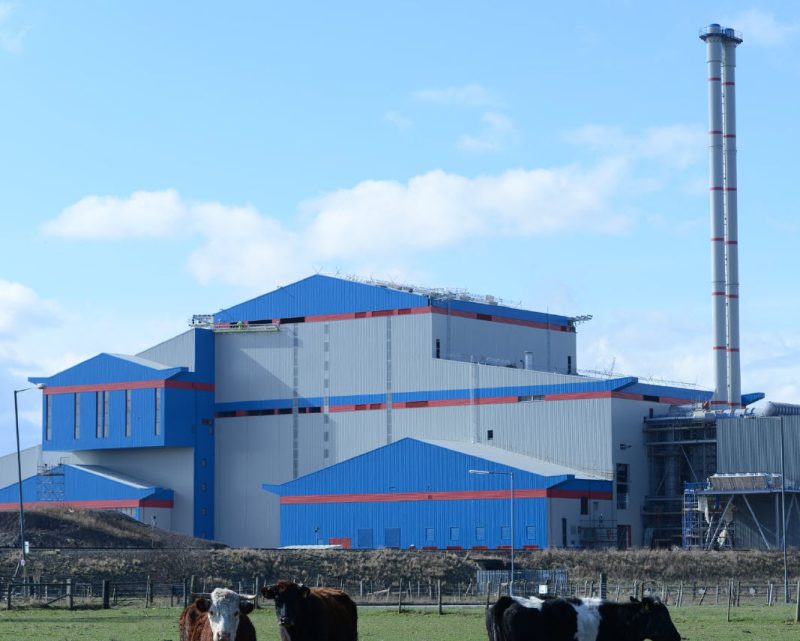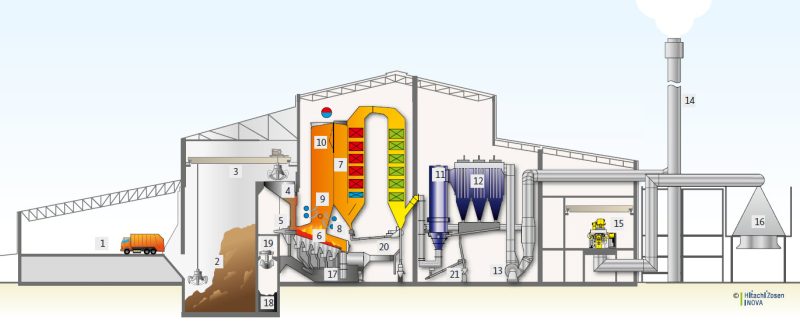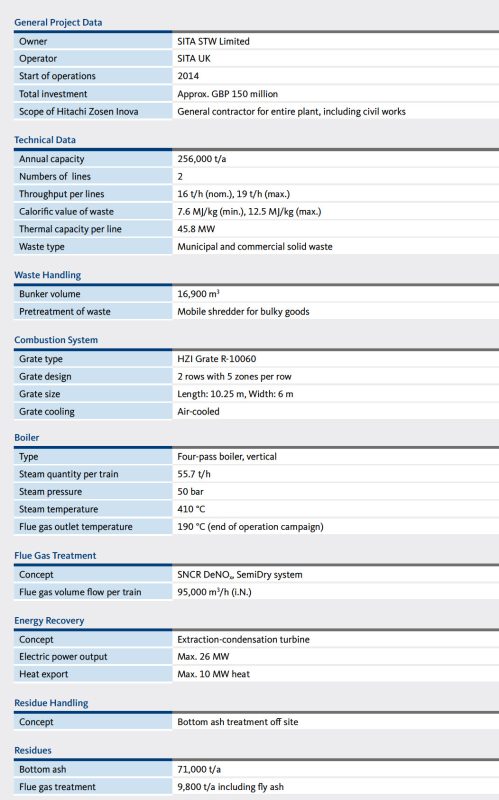Cleveland 4 & 5 / UK
Cleveland 4 & 5 / UK
Waste to Energy Plant
New Waste to Energy Plant on Teesside – Successful Cooperation Between Local Authority and Industry
The second extension of the existing Waste to Energy (WtE) plant on Teesside is a paradigm for continuity and reliability of the successful, integrated waste management in the North East of England. The two new lines are designed for 256,000 tonnes of waste per year, including the residual household waste on behalf of three North East councils.
In April 2011, a contract, which was let by the South Tyne & Wear Waste Partnership, was awarded to a consortium led by SITA UK which works with property group Lend Lease and I-Environment Investments Ltd, a subsidiary of ITOCHU Corporation. The contract is focused on the development of an WtE incinerator on Teesside. The facility will treat 190,000 tonnes per year of waste generated by the three councils in the partnership, which are Gateshead, South Tyne and Sunderland, as well as third party waste from commercial waste producers. In its role as EPC turnkey contractor, Kanadevia Inova fully supported the consortium until the common contract award. Shortly after contract signature, civil construction works started on site, followed by mechanical erection and commissioning for the facility to be ready for commercial operation in 2014.
Energy Which Comes from Continuity.
The independent new WtE plant is built at Teesside in the vicinity of three existing WtE lines operated by SITA UK. The third line of the existing plant was successfully completed by Kanadevia Inova and handed over on time in 2009 to SITA Northumberland Ltd under a PFI-contract scheme. The existing Teesside WtE facility exports about 30 MW of electricity by using waste considered as a renewable resource. The new plant further increases the export capacity by about 22 MW of electricity and provides the possibility to export heat, in combination with electricity, to neighbouring industries. The additional electricity exported to the national grid is equivalent to powering about 30,000 households.
Integrated Waste Management
The extension of the Teesside WtE plant strengthens the integrated waste management concept in the North East region which comprises community recycling centres, composting facilities and bottom ash recycling facilities.
Reliable Solution for Stable Operation.
Residual solid household and commercial waste is tipped by trucks into the waste pit within a closed waste reception hall. The waste pit is used as an intermediate storage for more than 4 days of autonomous operation as well as for thorough mixing of the heterogeneous fuel. The waste crane feeds the two independent lines either inmanual, semiautomatic or automatic operation mode. The fed waste is pushed onto the proven Inova Grate where it is completely burnt before the remaining ash falls into the chain slag extractor. The fully integrated control system allows rapid adjustments of the combustion conditions to changes in the waste composition for stable and efficient operation. Pyrolytic gases released from the waste are mixed with secondary air, which is injected tangentially at high velocity into the post combustion chamber above the grate, resulting in intensive mixing and a complete burnout of the flue gas characterised by very low CO emissions.
Efficiency in Energy Production
The thermal energy released by the combustion process is recovered in a Four-pass boiler which produces superheated steam. The chosen parameters of 50 bara/410 °C for the super-heated steam combine high energy efficiency and reliability of the boiler. The superheated steam is expanded in a condensation turbine, which produces electricity to supply the needs of the facility and exports about 89% of the gross electricity production to the national grid. For the sake of compactness, the boiler has a vertical design. The most important requirement to ensure the high availability of the plant is an effective boiler cleaning system consisting of a water-spray system for the 2nd pass, a soot blowing system for the 3rd pass and an explosion generation system in the 4th pass.
Clean Technology with Low Amounts of Residues
In the first pass of the boiler, the reduction of nitrous oxides is accomplished at a flue gas temperature of 850–900 °C by means of a proprietary Selective Non-Catalytic Reduction (SNCR) system. The system uses aqueous ammonia as the reducing agent. At the outlet of the boiler, the flue gas temperature is decreased to about 190 °C, which is necessary to allow for the effective and safe removal of hazardous substances, like dioxins or
heavy metals, from the flue gas by means of the proprietary semidry system. The proven flue gas treatment keeps the plant in full compliance with the permitted emission limits under any operation condition. The agents used are hydrated lime and activated carbon. The particulate flue gas treatment residues are separated in a fabric filter and sent for safe disposal in an appropriate landfill. The disposed residues amount to 3.5% of the waste
treated by the facility. The clean flue gas is finally released to the atmosphere through the 80 m stack.
Located next to the Waste to Energy facility is SITA UK’s ash recycling facility. The facility receives all the bottom ash from the Waste to Energy process at Teesside, from which various fractions of granules as well as ferrous and non-ferrous material are recovered for re-use.



